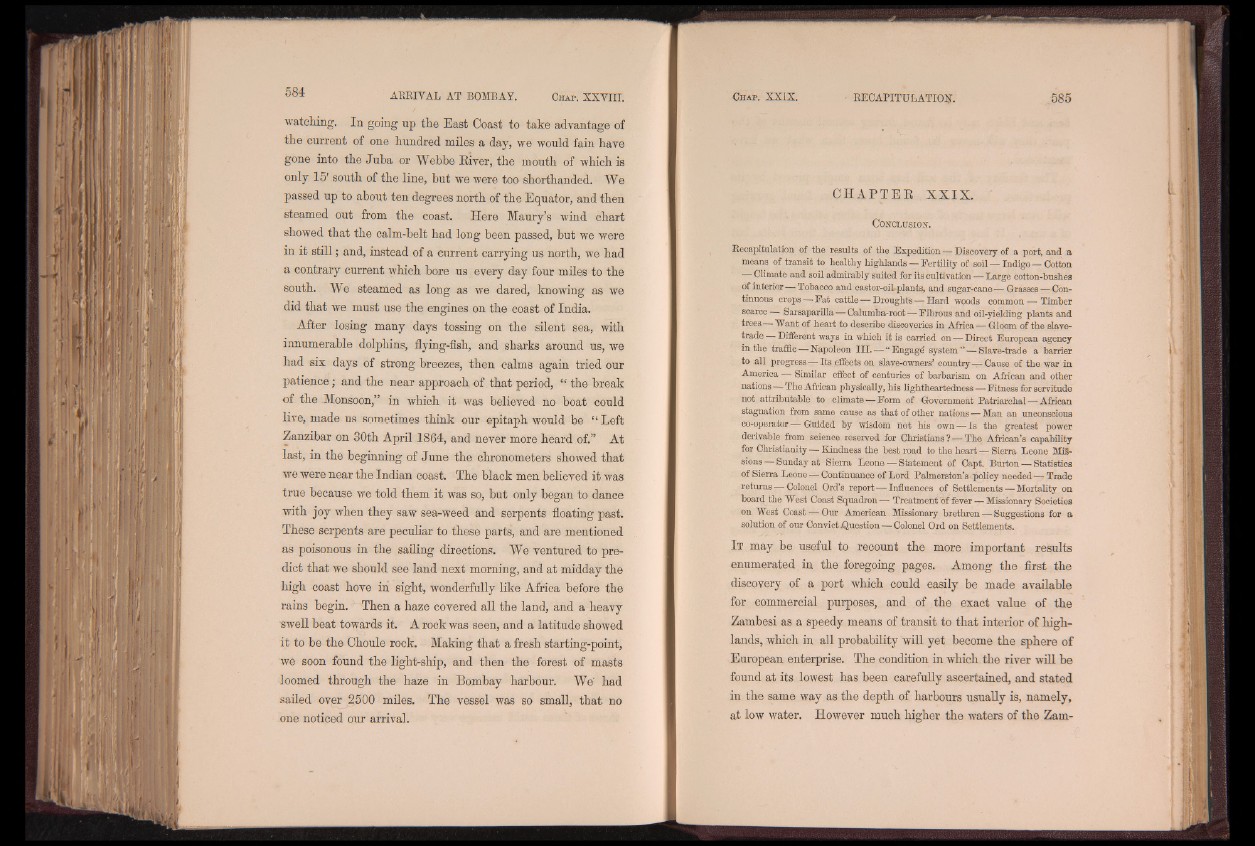
watching. In going up the East Coast to take advantage of
the current of one hundred miles a day, we would fain have
gone into the Juba or Webbe River, the mouth of which is
only 15' south of the line, but we were too shorthanded. We
passed up to about ten degrees north of the Equator, and then
steamed out from the coast. Here Maury’s wind chart
showed that the calm-belt had long been passed, but we were
in it still; and, instead of a current carrying us north, we had
a contrary current which bore us every day four miles to the
south. We steamed as long as we dared, knowing as we
did that we must use the engines on the coast of India.
After losing many days tossing on the silent sea, with
innumerable dolphins, flying-fish, and sharks around us, we
had six days of strong breezes, then calms again tried our
patience; and the near approach of that period, “ the break
of the Monsoon,” in which it was believed no boat could
live, made us sometimes think our epitaph would be “ Left
Zanzibar on 30th April 1864, and never more heard of.” At
last, in the beginning of June the chronometers showed that
we were near the Indian coast. The black men believed it was
true because we told them it was so, but only began to dance
with joy when they saw sea-weed and serpents floating past.
These serpents are peculiar to these parts, and are mentioned
as poisonous in the sailing directions. We ventured to predict
that we should see land next morning, and at midday the
high coast hove in sight, wonderfully like Africa before the
rains begin. Then a haze covered all the land, and a heavy
swell beat towards it. A rock was seen, and a latitude showed
it to be the Choule rock. Making that a fresh starting-point,
we soon found the light-ship, and then the forest of masts
loomed through the haze in Bombay harbour. We had
sailed over 2500 miles. The vessel was so small, that no
one noticed our arrival.
C H A P T E R XXIX .
C o n c l u s io n .
Recapitulation of the results of the Expedition ■—• Discovery of a port, and a
means of transit to healthy highlands L, Fertility of.soil — Indigo — Cotton
■ Climate and soil admirably suited for its cultivation — Large cotton-bushes
of interior — Tobacco and castor-oil*plants, and sugar-cane— Grasses—Continuous
crops — Fat cattle — Droughts-—Hard woods common — Timber
scarce Sarsaparilla—Calumba-root—Fibrous and oil-yielding plants and
trees Want of heart to describe discoveries in Africa — Gloom of the slavetrade
Different ways in which it is carried on—Direct European agency
in the traffic — Napoleon I I I .—“ Engage system ”—Slave-trade a barrier
to all progress — Its effects on slave-owners’ country—Cause of the war in
America — Similar effect of centuries of barbarism on African and other
nations — The African physically, his lightheartedness — Fitness for servitude
not attributable to climate—Form of Government Patriarchal—- African
stagnation from same cause as that of other nations—Man an unconscious
co-operator — Guided by wisdom not his own — Is the greatest power
derivable from science reserved for Christians? — The African’s capability
for Christianity — Kindness the best road to the heart — Sierra Leone Missions
— Sunday at Sierra Leone — Statement of Capt. Burton — Statistics
of Sierra Leone — Continuance of Lord Palmerston’s policy needed — Trade
returns — Colonel Ord’s report — Influences of Settlements — Mortality on
board the West Coast Squadron— Treatment'of fever — Missionary Societies
on West Coast-4-Our American Missionary brethren—-Suggestions for a
solution of our Convict jQuestion— Colonel Ord on Settlements.
I t may be useful to recount the more important results
enumerated in the foregoing pages. Among the first the
discovery of a port which could easily be made available
for commercial purposes, and of the exact value of the
Zambesi as a speedy means of transit to that interior of highlands,
which in all probability will yet become the sphere of
European enterprise. The condition in which the river will be
found at its lowest has been carefully ascertained, and stated
in the same way as the depth of harbours usually is, namely,
at low water. However much higher the waters of the Zam